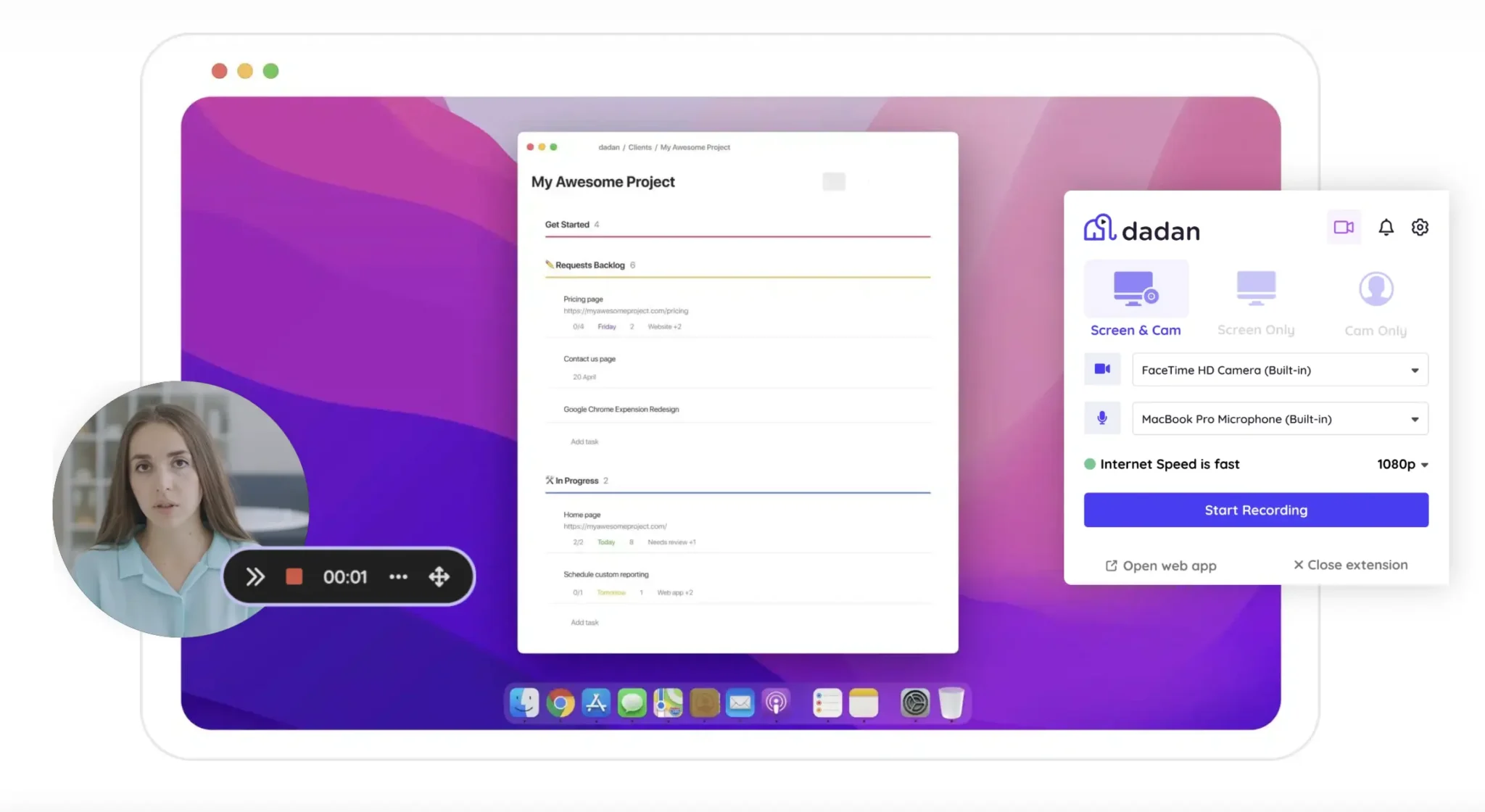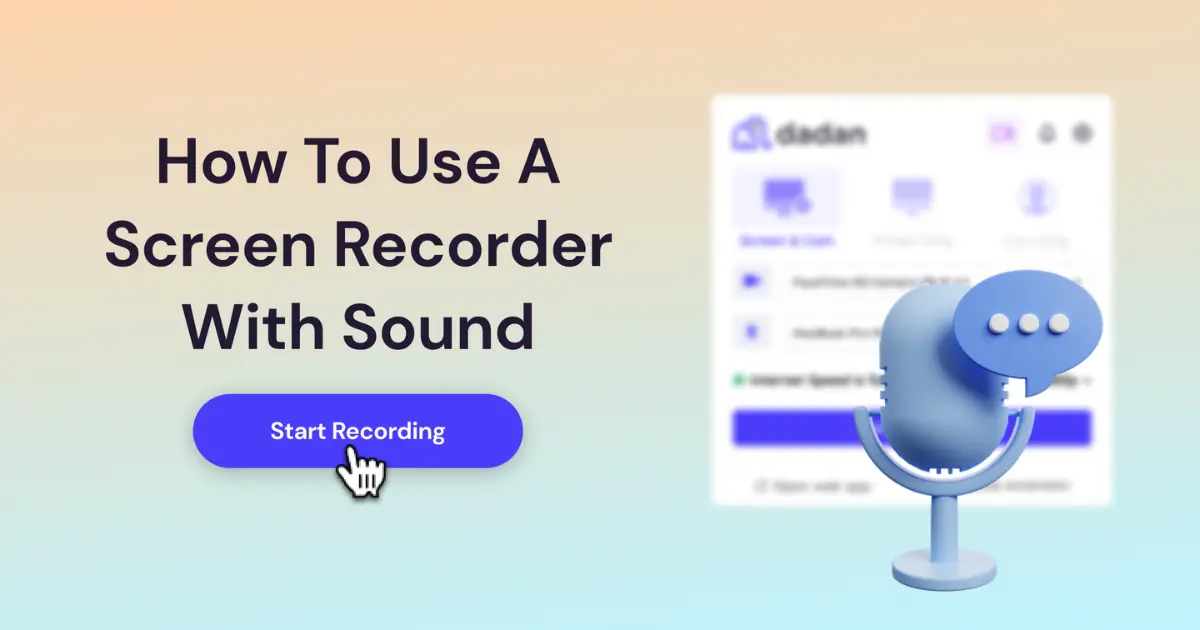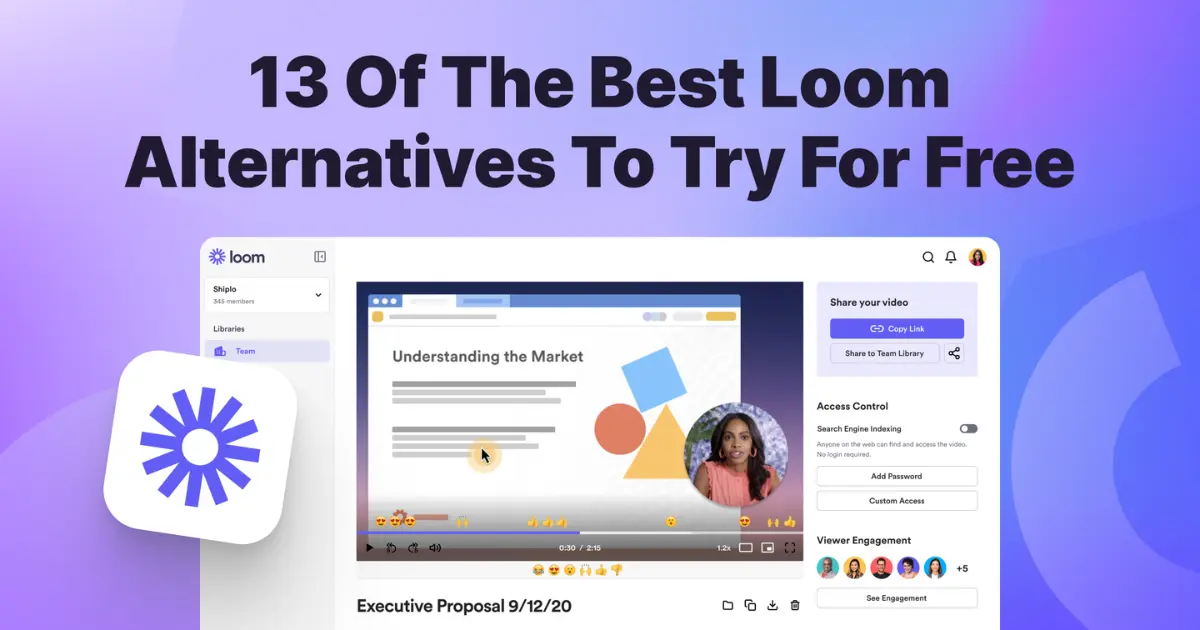TL;DR
How to use a screen recorder with sound on Windows 10 or 11
Windows 10 and 11 have a couple of in-built screen recorders with sound. Using the Snipping Tool or Xbox Game Bar is a quick way of creating simple screen recordings with audio.
How to use a screen recorder with sound on Mac
Use macOS’s built-in tools, such as Quick Time Player, for a simple-to-use screen recording tool that captures system and audio sounds.
How to use a screen recorder with sound with Dadan
Download Dadan to your Windows or Mac device for easy screen, webcam, and sound recording in one easy-to-use package.
Introduction
Video screen capture tools have become popular among businesses, education providers, and personal content creators thanks to their ability to record screens and webcams easily and capture audio.
Audio is an essential part of the best screen recorders since they allow you to add sound to your images to add context. Whether that’s as a voiceover during a product demo or presentation, commentary while gaming, or capturing your system’s audio during tutorials and educational guides, the difference between video captures with and without sound is enormous.
However, many users face common challenges when recording video and sound simultaneously. For instance, recording audio can compromise video quality. In addition, if you’re recording your webcam, sometimes the video and audio aren’t synchronized. This is where finding the right screen recording software matters.
This article explains how to record sound with your Windows 10 and 11 or macOS device, explores the best third-party software options, and explores using a screen recorder with sound on mobile devices.
Why screen recording with sound is important
Using a screen recorder with sound allows you to add explainers to your videos. In a business setting, this allows you to add depth and explanations to your presentations or demonstrations, using audio to explain the point you’re trying to present or how a new product works.
Meanwhile, in educational settings, recording your audio alongside your webcam and screen enables effective distance learning; it also allows lecturers and teachers to add context during webinars or as they provide feedback on assignments.
However, it’s not just the super-serious world of work and learning that screen recording with sound benefits. Gaming social media content creators can capture all the audible mayhem around them as they play COD or Fortnite while adding their commentary for their legions of followers to enjoy.
Not all screen recorders have the capability to record sound. So, while these might be suitable for simple tasks, such as logging issues for troubleshooting, this limited functionality hampers their effectiveness as business communication, educational, and social media content tools.
Built-in tools for screen recording with sound
Windows 10/11 Snipping Tool

Windows 10 and 11 have the built-in Snipping Tool to record video, audio, and static screen captures. Here’s how to capture your screen using it:
1. Open the Start menu, search for Snipping Tool, and open
2. Open Settings by clicking on the three dots on the top right-hand of the window
3. Enable your microphone to allow voiceovers
4. Select Record (the camera button)
5. Select New
6. Draw a square on the screen to determine the area you want to record
7. Click Start to begin recording
8. Select Pause to temporarily stop the recording
9. Click Stop to complete the recording.
Once you’ve stopped the recording, you can save and share effortlessly with direct links.
Xbox Game Bar

Another built-in tool on Windows 11 is the Xbox Game Bar.
1. Open the program you want to record and make sure it’s at the front of your screen
2. Click Windows + G to launch the Xbox Game Bar
3. Enable microphone audio to capture in Settings
4. Click Record
5. When you’ve finished recording, click Stop to end
6. Select Show all captures to find your recording and review it.
Mac (Quick Time Player)

All macOS devices have built-in screen recording tools, such as Quick Time Player.
1. Open Quick Time Player via your Mac’s launchpad
2. Click File and select New Screen Recording
3. Move the grey-shaded area to select the area of the screen you want to record
4. Click the Options tab and select the Microphone section. Toggle to your built-in mic or a third-party mic as you wish
5. Click Record to record your screen and audio.
6. Click Stop, and your recording will open automatically in the Quick Time player.
Third-party screen recording software
These three third-party screen recording software are also available on Windows and macOS.
Dadan

Dadan’s screen recorder is one of the most versatile and intuitive screen recording packages available for Windows and macOS. In addition to 4K video recording, webcam and audio capture, Dadan has many outstanding editing tools and auto-captioning to add accessibility.
Not only that, Dadan now has a webpage where you can test your mic and camera before you use the software.
Here’s a step-by-step guide to installing and using Dadan’s screen recording software:
1. Sign up for a free account at Dadan using your Google or Microsoft account
2. Download Dadan to your device using the Download for Windows or Download for Mac links at the top of the screen
3. Install Dadan’s screen recording software
4. Open the Dadan desktop app
5. In the Dadan window, select whether you want to record your screen, webcam, or both
6. Select the area you want to record – either your entire screen, a specific window, or part of your screen
7. Select which microphone you want to use
8. Click Start Recording to begin the video capture and add your voiceover
9. Click Stop in the pop-up toolbar to stop
10. Click on the Pencil icon to launch the editor and make any edits you require
Camtasia

Camtasia is another multi-platform screen recorder available for Windows and Mac that records video and audio and has high-end editing tools.
1. Sign up for a Camtasia account
2. Download Camtasia using the link
3. Install the screen recorder to your hard drive
4. Configure your video settings in the Camtasia Recorder to select your screen, webcam, or both
5. Select your audio settings to capture your system audio and/or your microphone
6. Drag the highlighted area to select the area of your screen to record using the handles
7. Click Record to begin your recording
8. Click Stop to end your recording
9. Use the built-in editor to personalize your content before exporting it to your hair drive
Loom

Loom is a popular screen recording software for Mac and Windows devices. It’s widely used by business and education professionals to facilitate remote video communication.
1. Create an account with Loom
2. Download Loom using the Windows or Mac links
3. Install the screen recorder software to your hard drive
4. Log in to your Loom account
5. In the Loom app, select whether you want to record your whole screen, a specific window, or a partial area of your screen and whether you want your webcam captured
6. Go to Settings to configure your audio settings to capture your system and microphone audio
7. Click Record to begin your recording
8. Click Stop on the pop-up window to end the recording
9. The video is automatically saved in the Loom Library with shareable links
Using a Screen Recorder with Sound on Mobile Devices
Android and iPhone devices also come with built-in screen recorders that can capture videos and content on your mobile devices along with audio.
Here’s a step-by-step guide to getting started on both types of devices.
Screen recording on iPhone
You can access an in-built screen recording app if you have an iPhone. Here’s how to activate and use it.
1. Go to Settings and choose Control Center
2. Locate the Screen Recording feature and, using the three lines to the left, drag it into the Included Controls section
3. On your phone’s Home Screen, drag down from the top middle of the screen to open your Control Center
4. Find the iPhone screen recording button – the small circle icon
5. Hold down the icon to launch a new tab with new recording options
6. Tick choices to set apps to Do Not Disturb as you record to prevent notifications
7. Click the button to turn on Microphone access and System Sound alongside your screen
8. Click Start to begin recording. You will get a 3-second countdown
9. Click the clock on your device with the red background to stop recording
10. The video will be automatically saved to your iPhone photo library
Screen recording on Android devices
Recording your screen on Android with audio is equally simple, following these simple steps:
1. Swipe down from the top of your phone screen to access your Quick Settings Panel.
2. Swipe right until you find your Screen Recorder icon (note, you must have Android 11 or later; otherwise, you’ll need to download third-party software from the Google Play Store)
3. Tap the Screen Recorder icon
4. Select whether you want to record Media only or Media and Mic
5. Tap Start Recording to begin recording and add your voiceover
6. Swipe down from the top of the screen and tap the Stop button
7. Tap the View button to review your recording
8. The video is automatically saved to your phone’s Movies folder
Advanced tips and tricks
Whether using your device’s built-in screen recorder or a third-party version, it’s essential to know how to optimize your settings to provide your audience with the best quality audio and visuals.
Try these tips and tricks for enhancing your screen recordings with sound.
Advanced settings
Learning how your software’s advanced audio settings work can help elevate your content to the next level. Review your videos and audio tracks before sharing them to ensure your images and audio are synchronized and that there’s no reverb, echo, or muffling affecting your voiceover.
External microphones, particularly those with wind protectors if you’re recording outside, can help improve sound quality by reducing external factors and echo. Meanwhile, adding a voiceover after the video has been recorded can also boost the audio quality, giving your content a more professional and smoother feel.
Another tip is to play around with audio levels to ensure a good balance between your system sounds and your microphone. Having one drowning out the other isn’t an excellent example of high-quality video content.
Editing
Many screen recorders have various editing tools that can help customize your video content, making it more personal to your brand and accessible to your audience.
Enhance your output by adding annotations to highlight important parts of your videos and add highlighted cursor movements so your audience can follow where you are on your screen. Some tools include captioning, which aids accessibility, with Dadan’s auto-captioning capability standing out.
In addition, being able to cut and snip your content helps make a seamless finish product, removing any part of your recording that doesn’t add value for your audience. Editing your video before sharing gives your content a final flourish that helps deliver engaging and appealing content.
Conclusion
The most effective screen recording software tools capture not only what’s on your screen but also your system and microphone audio to provide a comprehensive finished article.
Adding audio allows you to boost your video content with the aid of audio to add context and depth to your recordings in professional business and educational environments while aiding the exciting all-around capture of audio and commentary for social media gamers.
While some in-built tools may be sufficient for your screen recording needs, it’s a good idea to experiment with different packages to find the right one. Most third-party screen recording software allows you to take advantage of a free trial before you purchase a subscription, meaning you can make a well-informed choice before committing your hard-earned cash to a tool that doesn’t meet your requirements.
Why not begin with Dadan’s comprehensive screen recording software, which records video and audio and unlocks access to a massive array of editing tools in its comprehensive all-in-one solution? Sign up for your free 14-day trial today!
FAQs
How can I record both system audio and microphone input?
Most in-built and third-party screen recorders record your system audio and microphone input. Check your software audio settings to ensure your microphone is enabled.
Why is there no sound in my screen recording?
You may not have enabled audio and microphone capture on your system. Go into your app’s audio configuration to ensure your recorder captures your system and microphone audio.
Can I add my voiceover after the video has been recorded?
Yes, most screen recorders can add your voiceover after recording the video.
Can I record my screen on my Android 10 device?
To access the in-built screen recorder, you must have an Android 11 or later device. However, you can download a third-party app on earlier versions to record your screen.
Does my Windows or Mac device come with an in-built screen recorder?
Windows 10 and 11 machines have the Snipping Tool and Xbox Game Bar in-built. Meanwhile, macOS devices have tools like Quick Time Player, which are standard.
How do I know if my webcam and microphone are working?
You can use Dadan’s online cam and mic tester on their website to make sure your cam and mic are working.




